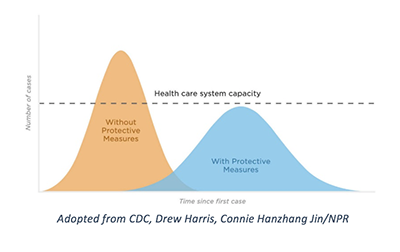You are here
Why Jordanians need to stay at home: The science of social distancing
Mar 18,2020 - Last updated at Mar 18,2020
As it stands today, an increase in infections locally and globally is an inevitable outcome that is bound to happen. Globally, efforts to “contain” the new novel coronavirus, an infectious virus that is responsible for over 7,500 deaths worldwide, have officially failed. This forces officials to move to another stage of dealing with the disease, the ‘delay’ stage. With over 200,000 cases worldwide, countries like the UK and Italy found themselves few thousand cases late to the party. In Italy, for instance, the number of infected individuals picked up rapidly within few days, far before any legislative policies and measures were put in place. Similarly, in the UK, Prime Minister Borris Johnson addressed the nation saying that people should be ready to lose loved ones, as the healthcare system will simply fail to contain the number of infected individuals. Such countries can only focus on delaying the inevitable and slowing down the unfortunate outcome of being knocked down by such a disease.
But this does not have to be Jordan’s reality. With such a disease having a rapid rate of infection, the rate at which a population becomes infected makes all the difference in whether there are enough hospital beds (and doctors, and resources) to treat the sick.
According to the official numbers from Johns Hopkins University in the US, there are currently over 200,000 cases worldwide. Only about 48 of those have been confirmed in Jordan, most of which have been identified to be in the country only in the last few days. This means that there has been a delay in coronavirus cases in Jordan when comparing it to Europe and Asia. This delay, luckily, allowed officials and policy makers in the country to understand the rate of infection of this disease and very quickly pick up the lessons from European countries. As of March 17th, Jordan has imposed a strict ban on public outings. This includes the closure of restaurants, coffeeshops and any gathering with more than ten individuals. Additionally, all travel has been banned and over 3,000 individuals who flew to the country over the past two days have been quarantined in various hotels in Amman and Dead Sea.
The curve
These extremely strict policies, although seen as controversial by many, are exemplary and absolutely necessary in an attempt to contain the spread of the coronavirus before it gets out of control. In epidemiology, these policies align with the necessary measures to control an epidemic. The notion of slowing a virus’ spread so that at any given time there is enough capacity at hospitals for treatment is known as “flattening the curve”. The Jordanian government has taken all required measures to flatten the curve. Here is what you need to know about the curve and your responsibility as a member of our community to aid in flattening it.

The curve shows the number of people infected against time from the first infection. The shape can take various forms, which ultimately depends on the virus's infection rate. The faster the infection curve rises, the quicker the local healthcare system gets overloaded beyond its capacity to treat people. As we are seeing in Italy, more and more new patients may be forced to go without ICU beds, and more and more hospitals may run out of the basic supplies they need to respond to the outbreak. Simply put, a flatter curve will result in the same number of people infected, but over a much longer time. This allows for everyone to be contained and treated in the hospital, and will ultimately result in a much, much less death rate compared to a steeper curve, as people are not turned away from hospitals due to capacity issues.
How do we flatten the curve?
With all the fantastic measures that have been put into place by the Jordanian government, the answer becomes simple: we have a social responsibility to stay at home. “Social distancing” is a necessary measure to flatten the curve of an epidemic, especially when no vaccine is currently available or foreseen in the near future.
Flattening the curve works. It worked repeatedly in history and has been supported by epidemiological science. In 1918, when the Spanish Flu caused a global pandemic, not too different from what we are experiencing now!, city officials in Philadelphia ignored all warning signs from infectious disease experts regarding the spread of the flu within the community. They even sponsored a parade that gathered hundreds of thousands of people on the streets. Within 48 hours, thousands of people started to die. Philadelphia sacrificed 16,000 people of its city within six months.
In St. Louis, city officials implement extremely strict social isolation policies, like those imposed by the Jordanian government at our current time. Schools shut down immediately, travel was limited and public gatherings were banned. As a result, the city managed to treat most of the people who were infected, albeit over a longer period of time. The result was the death of merely 2,000 individuals, only an eighth of what Philadelphia experienced concurrently.
Today, Jordanians are in a position of privilege amidst a global health crisis, with the number of infections not yet exceeding a hundred. While that number is bound to increase, we have a social responsibility to slow down the spread of the disease. The government has done its part adequately, the rest is up to our people. Let us stand together for our community by staying at home and practicing social isolation. Let us set a responsible example to our world and future generations.
Every action we take now is worth ten tomorrow and a hundred in a week. Every inconvenience and caution today will save hundreds if not thousands of lives. So please Jordan, let us stay responsible.
Yazan Al-Ajlouni is a Public Health Researcher at The University of Cambridge in the UK and at Columbia University Mailman School of Public Health in New York City. He has over a dozen peer-reviewed publications in the field of public health, in addition to co-authoring four book chapters focusing on Neighbourhood and Geo-Spatial Health. He contributed this aticle to The Jordan Times












